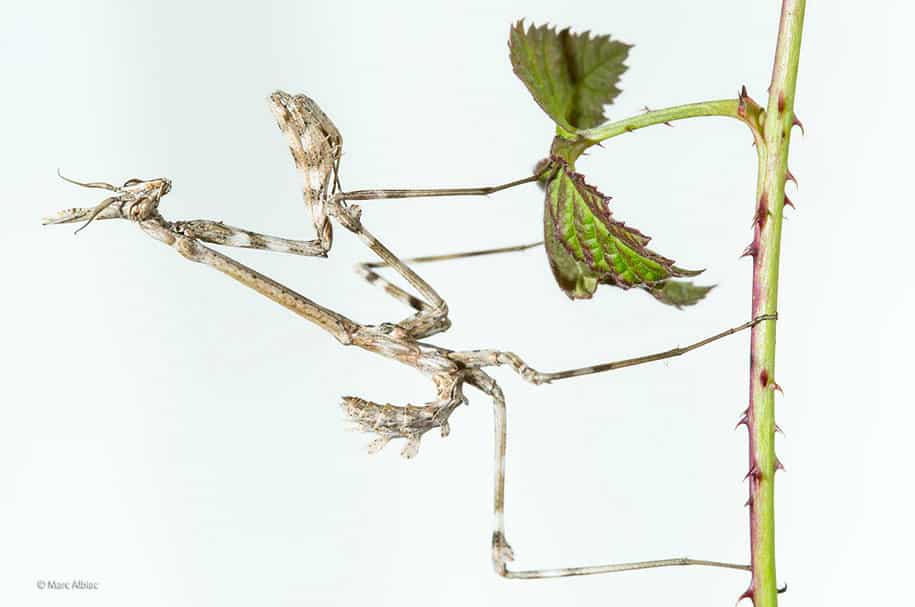23 Photos from Wildlife Photographer Of The Year
Held by the London Natural History Museum, the winners of the Wildlife Photographer Of The Year 2014 Awards has been announced. These Photographers have showcased the best shots of animals and nature from all around the world.
Receiving more than 42,000 entries from 96 countries, we’ll be showcasing the winners and finalists from the Adult and Young Wildlife Photographer for 2014 photographs below.
Wildlife Photographer of the Year is an annual international wildlife photographycompetition owned by the Natural History Museum and BBC Wildlife. It was known as BGWildlife Photographer of the Year from 1990 to 2003, and briefly as Shell Wildlife Photographer of the Year, Kodak Wildlife Photographer of the Year and PrudentialWildlife Photographer of the Year. The first competition was held in 1964, with three categories and around 600 entries. In 2008 the competition received over 32,000 entries from 3100 photographers in 82 countries. There is an exhibition of the winning and commended images each year at the Natural History Museum, which later tours around the world. It is often cited as being one of the most prestigious photography competitions in the world.
Checkout these 23 Photos from Wildlife Photographer Of The Year 2014Â below!
More info:Â nhm.ac.uk
“The Last Great Picture,†Wildlife Photographer of the Year 2014, Grand Title Winner, Black and White Category
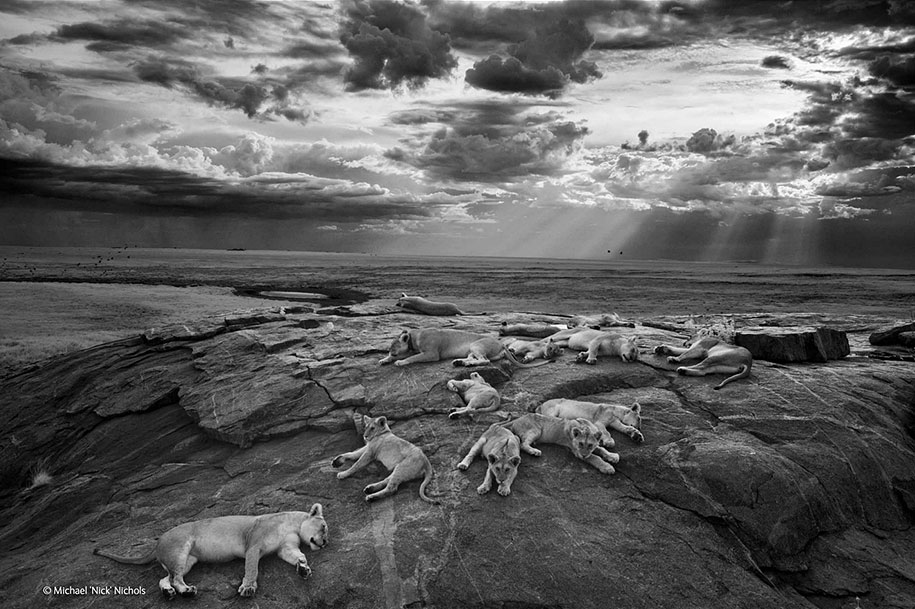
Nick set out to create an archetypal image that captured the essence of lions in a time long gone, before they were under such threat. The Vumbi pride in Tanzania’s Serengeti National Park are a ‘formidable and spectacularly co-operative team,’ Nick says. Here the five females lie at rest with their cubs on a kopje (a rocky outcrop). Shortly before he took the shot, they had attacked and driven off one of the pride’s two males. Now they were lying close together, calmly sleeping. They were used to Nick’s presence as he’d been following them for nearly six months, so he could position his vehicle close to the kopje. He framed the vista with the plains beyond and the dramatic late afternoon sky above. He photographed the lions in infrared, which he says ‘cuts through the dust and haze, transforms the light and turns the moment into something primal, biblical almost’. The chosen picture of lions in Africa is part flashback, part fantasy. Nick got to know and love the Vumbi pride. A few months later, he heard they had ventured outside the park and three females had been killed. (Photo credits: Michael ‘Nick’ Nichols, USA)
“Stinger In The Sun,â€Â Young Wildlife Photographer of the Year 2014, Grand Title Winner, 10 Years and Under Category
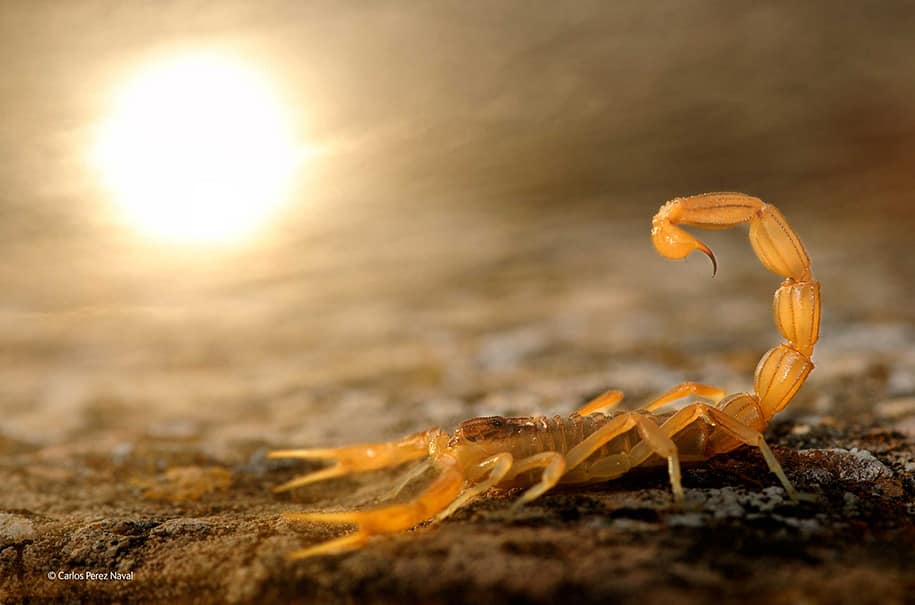
This common yellow scorpion is flourishing its sting as a warning. Carlos had found it basking on a flat stone in a rocky area near his home in Torralba de los Sisones, northeast Spain – a place he often visits to look for reptiles. The late afternoon Sun was casting such a lovely glow over the scene that Carlos decided to experiment with a double exposure for the first time so he could include it. He started with the background, using a fast speed so as not to overexpose the Sun, and then shot the scorpion using a low flash. But he had to change lenses, using his zoom for the Sun, which is when the scorpion noticed the movement and raised its tail. Carlos then had to wait for it to settle before taking his close-up, with the last of the light illuminating its body. (Photo credits: Carlos Perez Naval, Spain)
“The Mouse, The Moon And The Mosquito,†Winner In Mammals Category
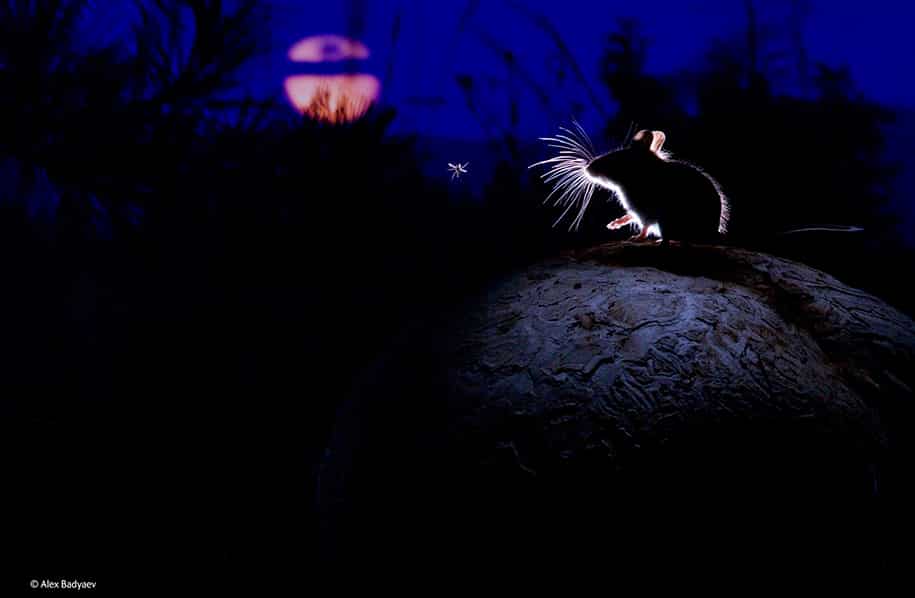
Alexander was taking his daily hike along a trail in the Blackfoot Valley, western Montana, USA, when he noticed a giant puffball mushroom starting to inflate. Squirrels, chipmunks and mice began exploring and scent-marking the surface of the oversized fungus leaving it covered with tiny prints. Alex returned to the spot during a full Moon, when the puffball had reached its maximum size. He lay on the ground, watching and waiting, entertained by the dozens of small animals exploring the puffball. The most frequent visitors were deer mice, which scampered around, sometimes pausing to check on their surroundings. To avoid disturbing the animals, and to preserve the sense of place, Alex used the Moon as his backlighting. He relied on a long exposure and a gentle pulse of flash to show the curve of the fungus and to capture the frantic activity. When one deer mouse paused for a moment to investigate a persistent mosquito, the perfect midnight puffball scene was created. (Photo credits: Alexander Badyaev, Russia/USA)
“Glimpse Of The Underworld,†Winner In Plants And Fungi Category
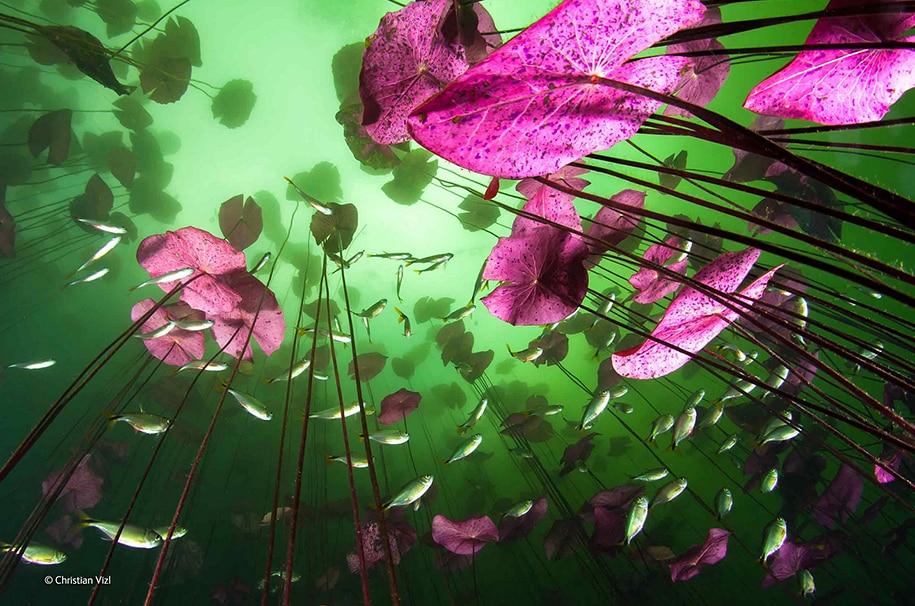
Water lilies stretch up to the light through a layer of green mist in the Aktun Ha cenote, a huge sinkhole on Mexico’s Yucatán Peninsula. Aktun Ha is part of a great ring of thousands of cenotes, created when the limestone bedrock collapsed to expose the subterranean groundwater. Christian has been photographing the cenotes for the past 10 years. What makes Aktun Ha special is its underwater garden. The water is crystal clear, except in summer when an algal bloom several metres thick can develop beneath the surface. Christian settled on the bottom of the cenote to compose a picture of this still, silent underworld garden. The challenge was to balance the artificial with the natural light. The intensity and angle of the strobe illumination had to be just right. He wanted to bring out the texture of the leaves, flushed pink through ageing, without detracting from the natural light filtering down through the algae, or overexposing the skittish silvery fish. The resulting picture hints at why the ancient Maya considered cenotes to be sacred places and thought of water lilies as plants of the underworld. (Photo credits: Christian Vizl, Mexico)
“Herons In Time And Space,†Winner In Birds Category
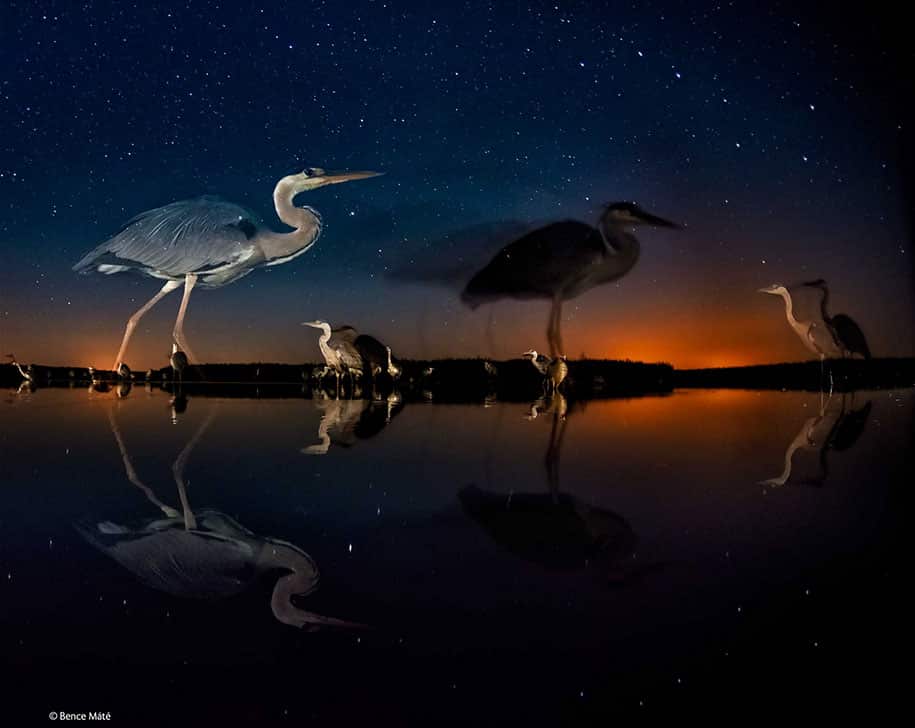
Bence had set up his hide to overlook Lake Csaj in Kiskunság National Park, Hungary. He had a specific image in mind and had planned to use both artificial and natural light. His subject was the shy grey heron. To overcome the various technological challenges of a night-time shot, he had built two timing devices for his camera to execute the single exposure. One device moved the focus, while the other adjusted the aperture within a single frame, so both the herons and the stars were in focus. It took 74 nights in the hide before the conditions were right and it all came together. The surface of the lake was still, reflecting the stars, and the sky was clear and motionless. Just after midnight, the seven stars of the Plough (part of the Ursa Major constellation) slid into position above the glow of a distant town. Bence took the shot, with both the stars and herons sharp, but with traces of the birds’ movement leaving ghostly impressions against the sky. Blending technology and passion in a masterful manner, Bence had finally created a picture that he had planned for many years – of herons imprinting their images in time and space. (Photo credits: Bence Máté, Hungary)
“Divine Snake,†Winner In Amphibians And Reptiles Category
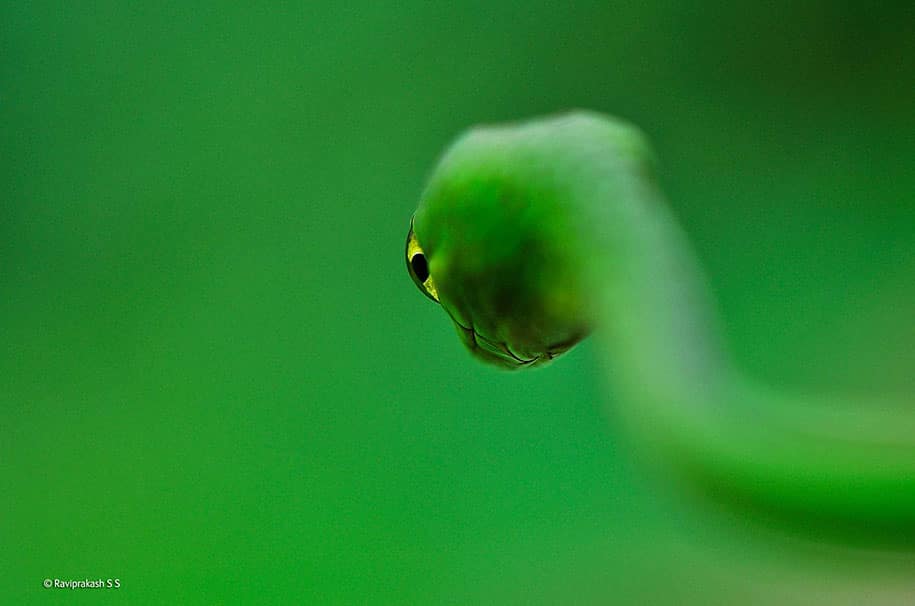
During the Indian monsoon season, green vine snakes often venture near houses. In this case one slithered just a few metres away from Raviprakash’s front door in Karnataka, in the heart of the Western Ghats. The snakes are attracted by the lizards and frogs that shelter among the vegetables and flowers in his garden. In the past two or three years he has ‘mastered the skill of identifying them amid a mass of green’. This snake appeared to be a plant at first glance – it was even swaying in the breeze. ‘A vine snake tends to spend a considerable amount of time in the same location,’ says Raviprakash. ‘It will wait for prey with divine concentration,’ before freezing in position once it has its prey in sight. The main challenge was to show the snake from this unusual perspective, without disturbing its concentration. Raviprakash says, ‘The green vine snake is one of the most beautiful creatures I have ever seen. Each time I photograph one, it looks ever more beautiful.’  (Photo credits: Raviprakash S S, India)
“Night Of The Deadly Lights,†Winner In Invertebrates Category
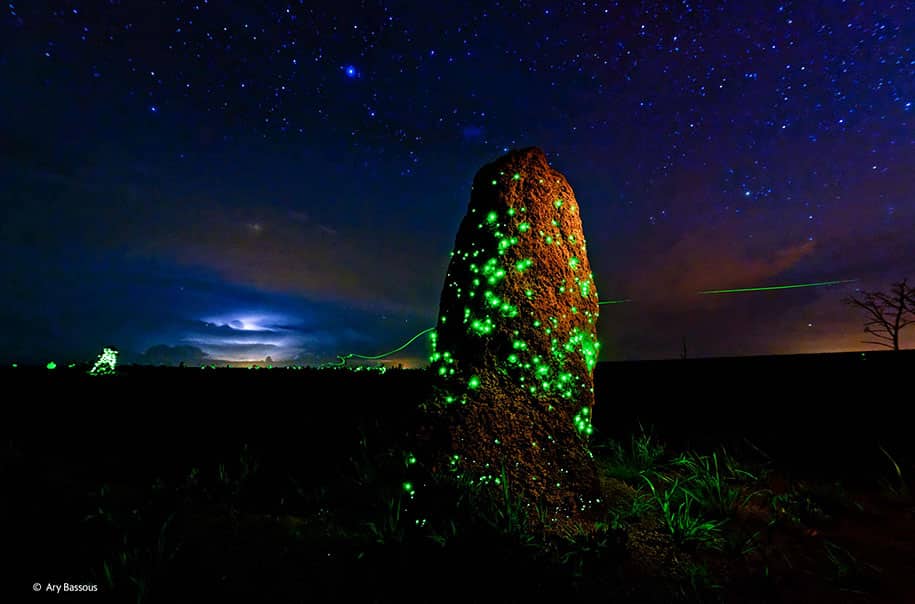
On still, humid nights, the old termite mounds on the savannah of Emas National Park, central Brazil, sparkle with eerie green lights. These are the bioluminescent lures of click beetle larvae living in the outer layers of the mounds. When conditions are right, they poke out of their tunnels. Shining their ‘headlights’, they wait for prey – usually flying termites that emerge on humid evenings to mate and look for new places to colonise. Ary lit this mound with a flashlight and kept the shutter open for 30 seconds to blur the insects’ flashes. This resulted in small pools of intense colour if the larvae remained still, or starbursts if they wriggled. Some adult beetles were flying, painting their flight paths against the starry sky. The orange glow of two towns and streaks of lightning were visible in the distance. To catch the peak of the phenomenon, which occurs after the first wet season rains and lasts for only a couple of weeks, Ary would stay in the park overnight. Despite occasional ‘bouts of crippling fear’ at the thought of jaguars and other dangerous animals that might be out after dark, he says the experience and resulting pictures were worth it. He achieved a shot he had been trying to capture for nearly a decade. (Photo credits: Ary Bassous, Brazil)
“Passing Giants,†Winner In Underwater Species Category
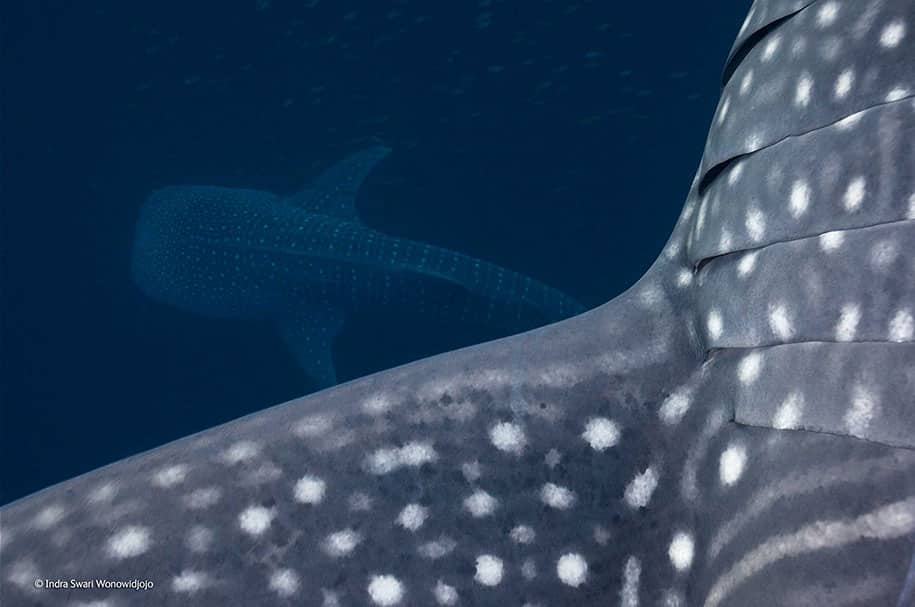
During a new Moon, the lights from the bagans (semi-mobile fishing platforms) in Cenderawasih Bay in Irian Jaya, Indonesia, attract shoals of fish into the nets of local fishermen. The lights act as a signal to filter-feeding whale sharks, which have learned to suck on the nets to extract the fish. It’s an easy meal, so easy that the whale sharks sometimes need to be shooed away from the nets, though some fishermen will feed them. Up to 10 whale sharks can cruise around a bagan at any one time, and the location is now becoming a dive hotspot. Attracted by the spectacle, Indra spent a few days diving there. As a huge whale shark – at least nine metres long – glided by on one dive, she noticed another swimming a little deeper, in a different direction. She swam quickly to position herself above both of them when their paths crossed. She adjusted her strobe output and ISO so the great fish would both be sufficiently illuminated. ‘The sharks will happily swim straight into you, gently nudging you out of their way,’ she says. ‘The fishermen see them as good omens and often jump in and swim with them.’ Elsewhere in Asia, these massive animals, the world’s largest fish, continue to be hunted. (Photo credits: Indra Swari Wonowidjojo, Indonesia)
“Apocalypse,†Winner In Earth’s Environments Category
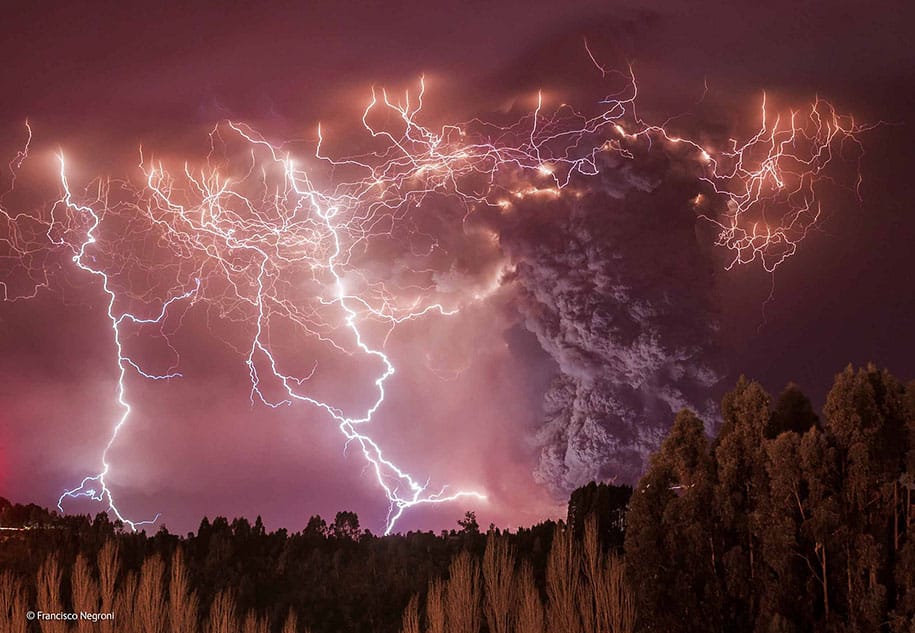
As the Puyehue-Cordón Caulle volcanic complex began erupting, Francisco travelled to Puyehue National Park in southern Chile, anticipating a spectacular light show. But what he witnessed was more like an apocalypse. He watched, awestruck, from a hill quite a distance to the west of the volcano. Flashes of lightning lacerated the sky, while the glow from the molten lava lit up the smoke billowing upwards, illuminating the landscape. ‘It was the most incredible thing I’ve seen in my life,’ Francisco says. Volcanic lightning (also known as a dirty thunderstorm) is a rare, short‑lived phenomenon. It is probably caused by static electrical charges resulting from fragments of red‑hot rock, ash and vapour crashing together high in the volcanic plume. The Puyehue-Cordón Caulle eruption spewed 100 million tonnes of ash high into the atmosphere, causing widespread disruption to air travel in the southern hemisphere. Volcanic activity continued at a lesser level for a year, spreading a layer of ash over the region. (Photo credits: Francisco Negroni, Chile)
 “Cardinal Sparks,†Winner In Natural Design Category
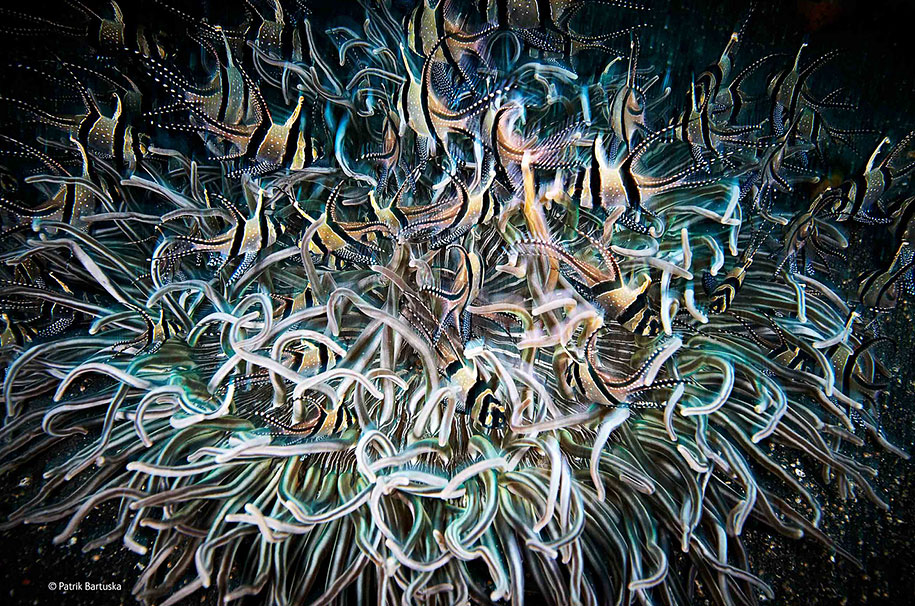
Patrik’s goal was to photograph a group of beautiful Banggai cardinalfish, which are found only in the waters off Sulawesi, Indonesia. They are endangered because of overfishing for the aquarium trade. Patrik encountered this scene while diving in the Lembeh Strait to the north. The contrasts of movement and texture entranced him – the anemone’s soft tentacles swaying in the current and the flicks of the angular, patterned fish sheltering within them. During his trip he mostly came across small groups of adults gathered around the coral. But he was after a group associating with an anemone. During the day juveniles use the anemones’ tentacles for protection, either avoiding their stings or being in some way unaffected by them. It took many dives before he found this large grouping. It appeared to Patrik like an underwater fire display, the tentacles like licking flames and the fish like erratic sparks. To capture the moving pattern he chose to shoot from above. Holding his position in the current, he waited for the fish to move so he could frame the composition. (Photo credits: Patrik Bartuska, Czech Republic)
The Price They Pay,†Winner In World In Our Hands Category
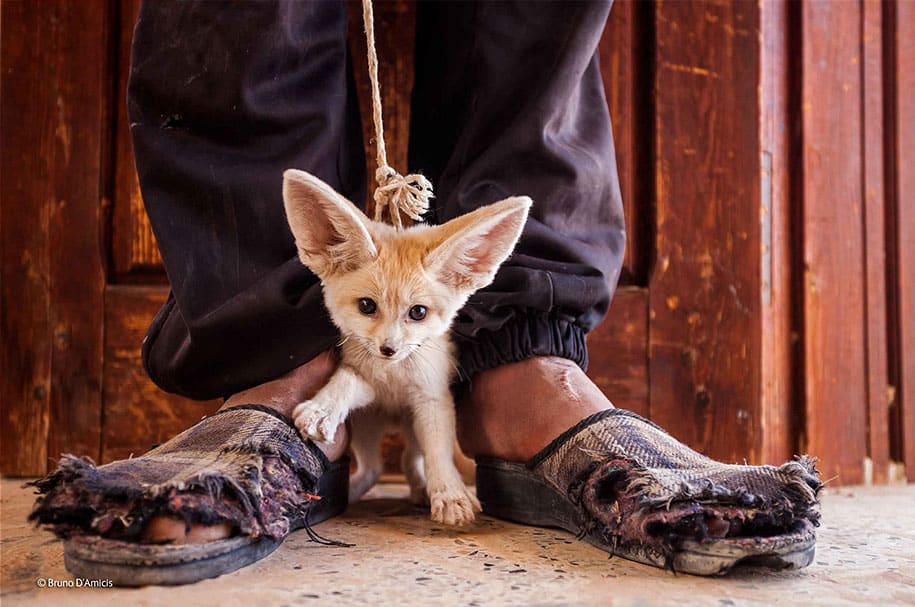
Bruno found a teenager selling a three-month-old fennec fox in a village in southern Tunisia. The pup was from a litter that he had dug out of a den in the Sahara Desert. Catching or killing wild fennec foxes is illegal in Tunisia, but it is still widespread. Bruno was working on a long-term project to investigate the issues facing endangered species in the Sahara. He gained the confidence of villagers in Tunisia, Algeria and Morocco and discovered widespread wildlife exploitation, including the hunting and capture for commercial trade and traditional medicine. He also discovered that the causes, and therefore the solutions, are complex. Contributory factors include high unemployment, poor education, lack of enforcement of conservation laws, ignorant tourists and tour companies, habitat destruction, and the sociopolitical legacy of the Arab Spring revolts. But Bruno is convinced that change is possible. He believes that thought‑provoking images can help raise awareness among tourists and highlight what’s happening to the Sahara’s fragile environment. (Photo credits: Bruno D’Amicis, Italy)
“The Long Embrace,†Winner In 15-17 Years Category
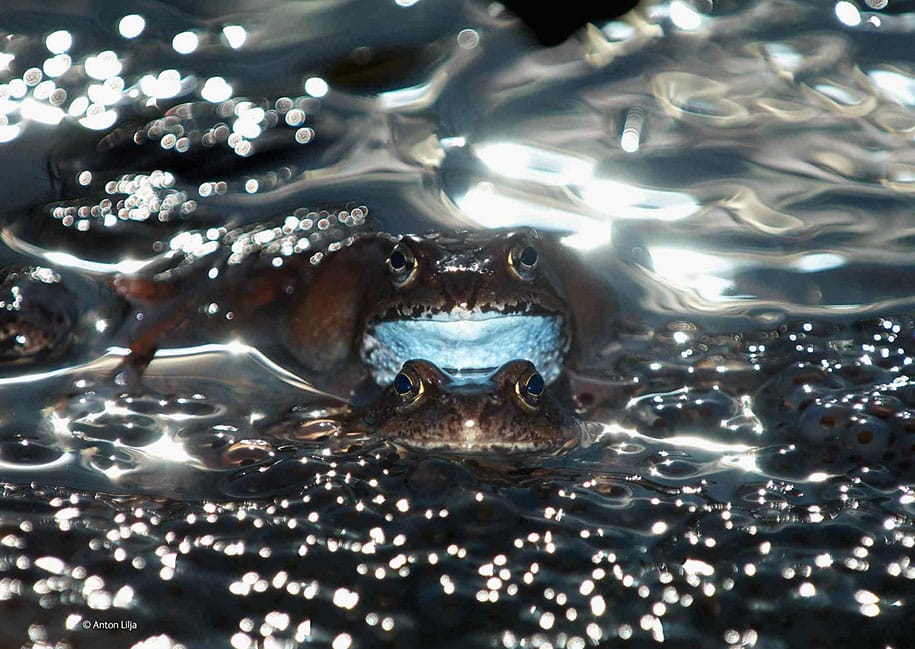
When Anton heard that masses of common frogs had gathered in a flooded gravel pit near his home in Västerbotten, Sweden, he set out to photograph the mating spectacle. Male frogs need to fertilise the female’s eggs the moment they leave her body – once the eggs hit the water, the surrounding jelly swells to form frogspawn, making fertilisation impossible. To make sure he’s there at the right moment, the male grasps its mate in a tight embrace, known as amplexus. Amplexus often lasts for days, with the male holding onto the female until it has laid her eggs. Lying down on the bank at eye level with the water, Anton became fascinated by the light bouncing off the frogspawn and the water, now vibrating with the activity of the frogs. Experimenting with his flash, he achieved the effect he wanted just as a pair of frogs bobbed in front of the camera. They stayed in position amid the glossy frogspawn, allowing Anton time to compose his shot. (Photo credits: Anton Lilja, Sweden)
“Facebook Update,†New Special Award Winner: People’s Choice
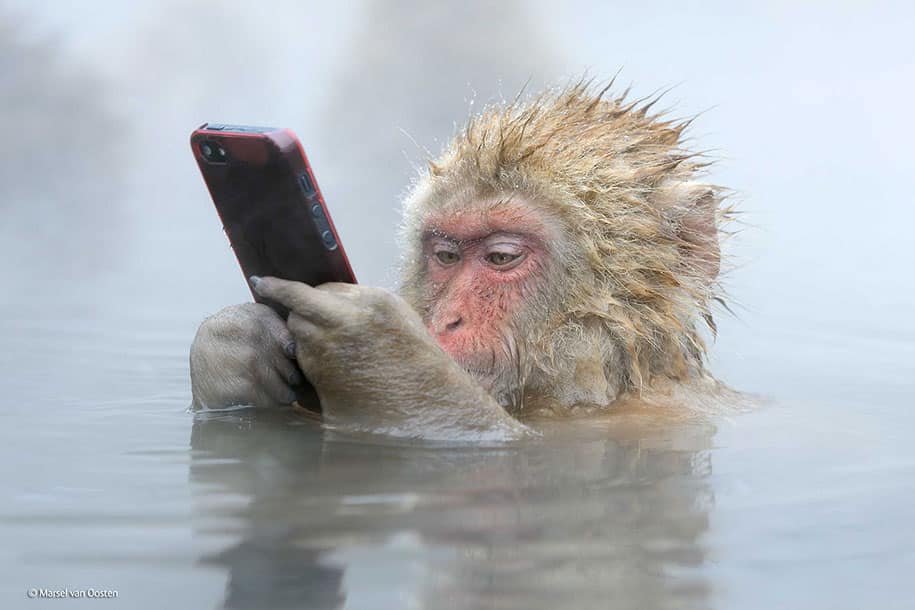
A tourist at Jigokudani Monkey Park, Japan, was so desperate to get a close-up of this young Japanese macaque in a natural hot spring that she held her phone ever nearer to her subject. Suddenly, the monkey snatched the device from her hand and retreated to the middle of the water to examine its prize. Marsel, who was leading a photographic tour at the time, saw the chance for a striking picture. His main challenge was the steam rising from the 42˚C water into the freezing air. ‘I wanted a really low angle,’ he explains, ‘but that meant getting close to the water. My lens was cold and kept fogging up, making focussing almost impossible.’ At first, the macaque just fumbled with the gadget. It had no idea what it had stolen but was nonetheless pleased with its new toy. It even managed to let the built-in flash go off a few times. When it finally held the phone just as a human would, looking intently at the screen, Marsel was ready to capture the image he had envisaged. Japanese macaques are thought to display culture, where a learned behaviour (most famously washing food) is passed on to other troop members and their descendants. But it remains to be seen if future generations of tech-savvy macaques emerge. (Photo crtedits: Marsel van Oosten, The Netherlands)
“Angle Poise,†Winner In 11-14 Years Category
If the praying mantis moved, Marc knew he might never find it again as its camouflage was so good. He’d been helping his grandmother tidy up her garden in Barcelona, Spain, when he spotted the conehead mantis among the brambles. Though he’s been taking wildlife photos for eight years, he’d never seen a conehead before and was desperate to photograph it – but he didn’t have his camera. There was only one thing for it. Leaving his grandmother with strict instructions not to let the insect out of her sight, Marc rushed home and picked up his equipment. The mantis blended so well with the background and the light was so low, his first pictures failed to reveal the exquisite detail of the animal. Then he had brainwave. Careful not to scare his subject, which kept an eye on him all the time, he taped a sheet of white paper behind it. Bouncing one flash off the paper, he managed to capture the insect’s extraordinary shape, colour, posture and behaviour, and create a perfect portrait. (Photo credits: Marc Albiac, Spain)
“Touché,†Finalist In The Birds Category
The focus of Jan’s trip to Ecuador was the astonishing sword-billed hummingbird, the only bird with a bill longer than its body (excluding its tail). Its 11-centimetre bill is designed to reach nectar at the base of equally long tube-shaped flowers – but Jan discovered that it can have another use. One particular bird had a regular circuit through the forest, which took in its favourite red angel trumpet flowers and the bird feeders near Jan’s lodge. To get to the bird feeders, it had to cross the path of a fiercely territorial collared inca hummingbird. Rather than being scared off, the sword-billed hummingbird used its bill to make a statement once or twice a day. To capture one of these intensive yet colourful stand offs, Jan set up multiple flashes to freeze the hummingbirds’ wing-beats, of which there are more than 60 every second. (Photo credits: Jan van der Greef, The Netherlands)
“The Longline Lottery,†Finalist In The World In Our Hands Category
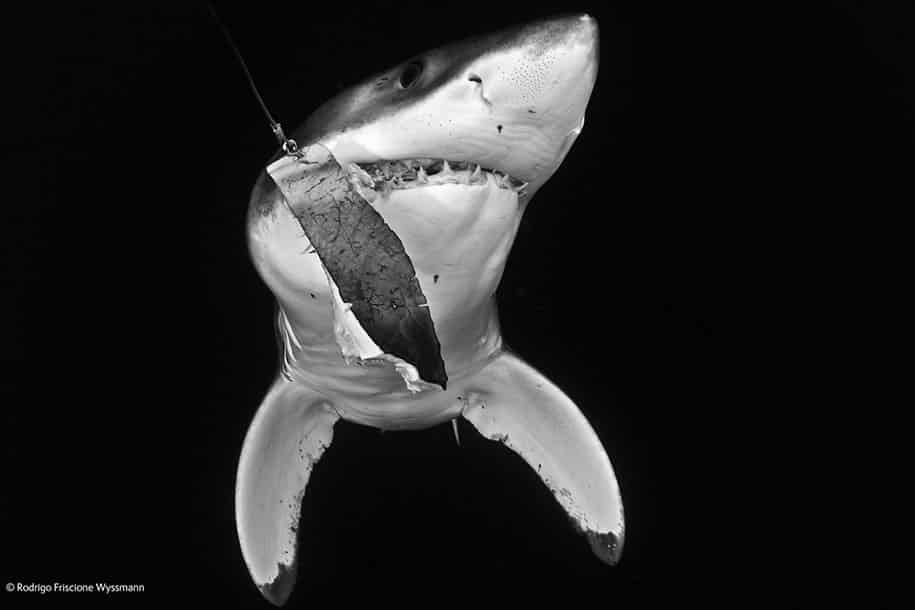
Rodrigo came across this grim sight off Magdalena Bay on the Pacific coast of Baja California, Mexico. He had followed the path of a fisherman’s buoy that had been dragged below the surface by a considerable weight. It had clearly been a monumental struggle. The young great white shark’s jaw jutted out at an ugly angle, evidence of how it had fought to escape from the hook before finally suffocating. ‘I was shocked,’ Rodrigo says. ‘Great whites are amazing, graceful and highly intelligent creatures. It was such a sad scene that I changed the image to black and white, which felt more dignified.’ The hook was on a long line of hooks, set up to catch blue and mako sharks. These baited long-lines may stretch for many miles and are responsible for the deaths of tens of thousands of animals every year, many of them endangered. (Photo credits: Rodrigo Friscione Wyssmann, Mexico)
“Snowbird,†Finalist In The 15-17 Years Category
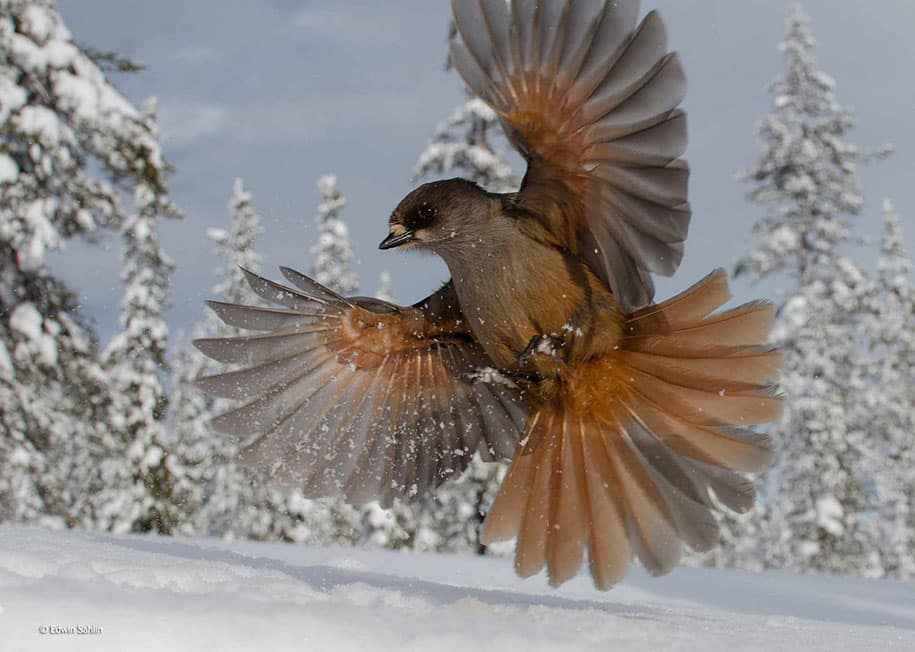
Edwin discovered that cheese and sausages are the snack of choice for Siberian jays while he was on a skiing holiday with his family in northern Sweden. Whenever they stopped for lunch, he would photograph the birds that gathered for their scraps. On this occasion, Edwin had dug a pit in the snow deep enough to climb into. He scattered titbits of food around the edge of the pit and waited. To his delight, the jays flew right over him, allowing him to photograph them from below, and capturing the rich rusty colours of their undersides more clearly than he had hoped. (Photo credits: Edwin Sahlin, Sweden)
“Feather Heavy,†Winner Of Special Award: Rising Star Portfolio Award
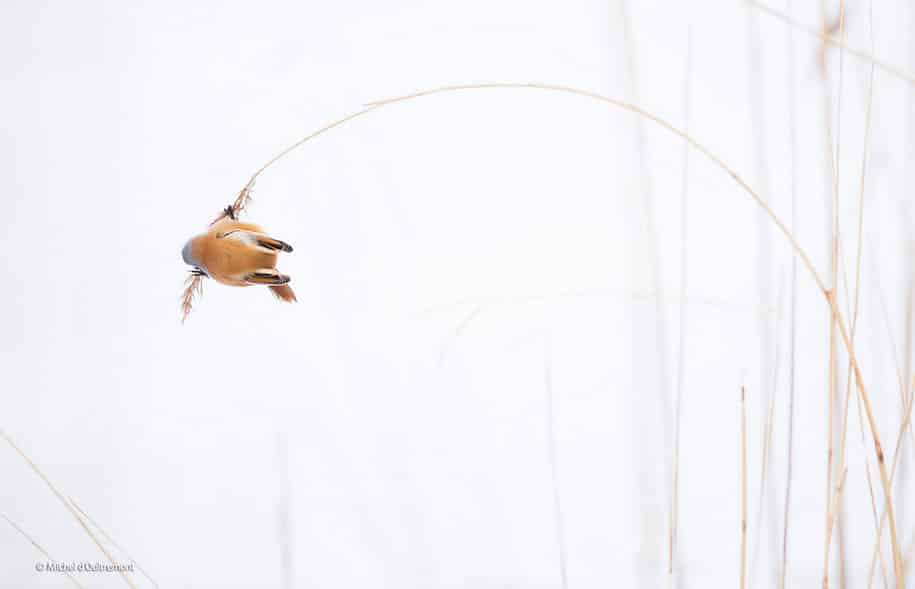
In winter, when there are few insects about, bearded tits feed mainly on reed seeds. Michel heard that a flock of them had congregated in a reed bed on a frozen lake near Rotterdam. As he walked into the reed bed, he first heard the ‘ping’ calls of the tits, before finally spotting a tiny bird on a bobbing reed head. This shot was one of the rare moments when the view was clear, the reed had stopped swaying, and the colours of the male’s beautiful plumage were in full view. (Photo credits: Michel d’Oultremont, Belgium)
“Ocean Blues,†Finalist In Underwater Species Category
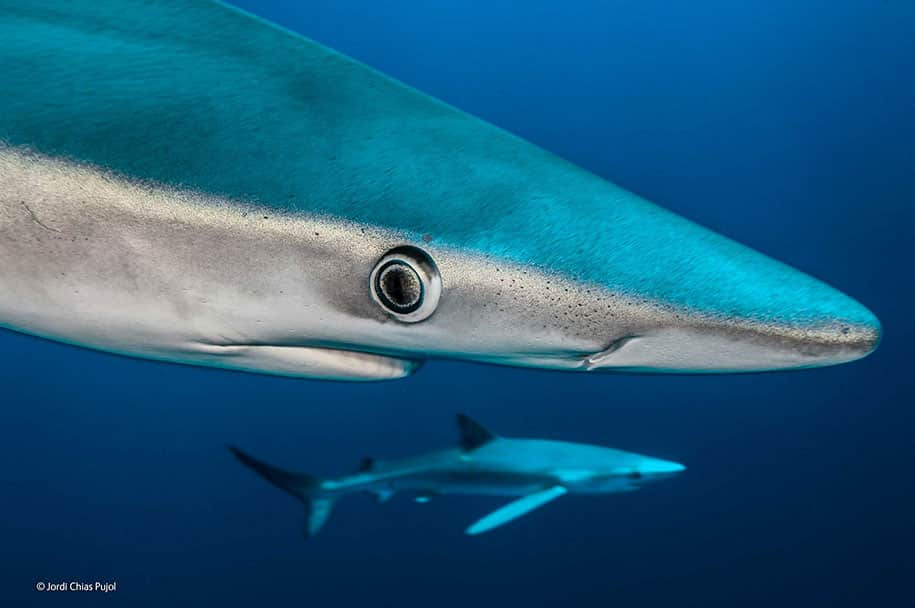
Diving off Santa Maria island in the Azores, Jordi relished his close encounters with blue sharks. ‘Sometimes they came within centimetres,’ he says. ‘They’re such beautiful animals, such elegant swimmers – it was a great spectacle.’ He spent a while shooting wide-angle images before turning his attention to the detail of their slender bodies. He had in mind a picture of two blues – one close up, another further away in profile. But with the sharks constantly cruising, framing the right moment was a challenge. When they fleetingly aligned he was ready, capturing the perfect blue shark portrait. Blue sharks are widespread and presumed abundant, though there are no population estimates. They migrate vast distances across the Atlantic, feeding mainly on bony fish and squid. But there is concern for their future. They are the most heavily fished shark species, with an unsustainable annual catch estimated at 20 million, mostly through longline and drift net fishing by-catch. Many are caught in European waters, and their fins are sold to the Asian market. There is now a campaign to create a shark sanctuary around the Azores, given that shark diving in the area is a more lucrative industry than fishing. (Photo credits: Jordi Chias Pujol, Spain)
“You Have Been Warned,†Finalist In Invertebrates Category
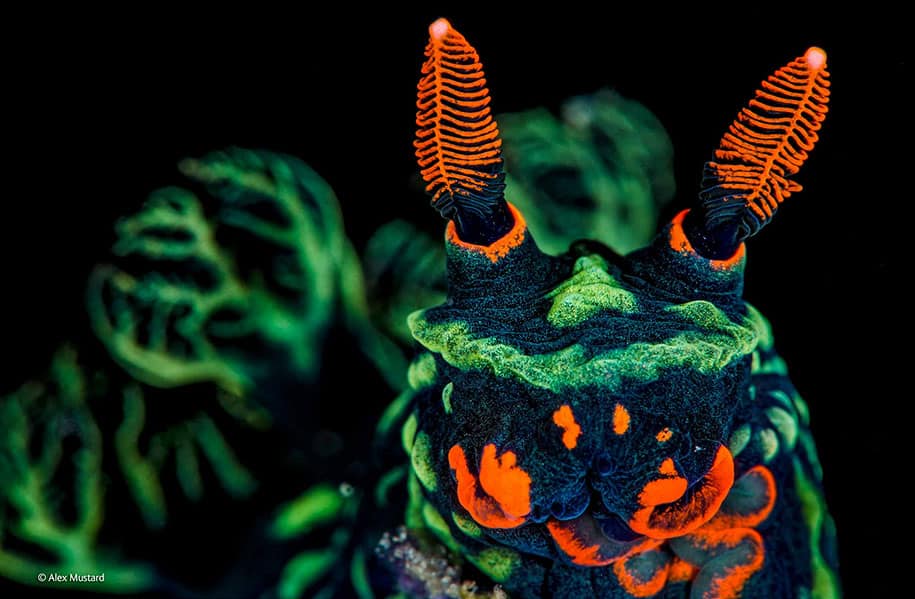
When Alex went diving in the Lembeh Strait in North Sulawesi, Indonesia, he was on a mission to celebrate the smaller sea creatures. Equipped with a new high-magnification lens, he encountered this variable neon nudibranch, a species of sea slug, crawling across the seabed. Less than two centimetres long, it has green gills on its back and orange mouthparts. It uses its orange, feather-like rhinophores to smell out its prey, primarily sea squirts. It incorporates distasteful chemicals from sea squirts’ skin into slimy mucus, and uses its neon colours to warn predators that it tastes bad. Alex wanted an eye-level view of this unforgettable mollusc. But even with a small aperture it was a challenge. There was little depth of field and the subject was moving – and even a slug’s pace under magnification is surprisingly fast. (Photo crdits: Alex Mustard, United Kingdom)
“Jelly Fireworks,â€Â Finalist In Underwater Species Category
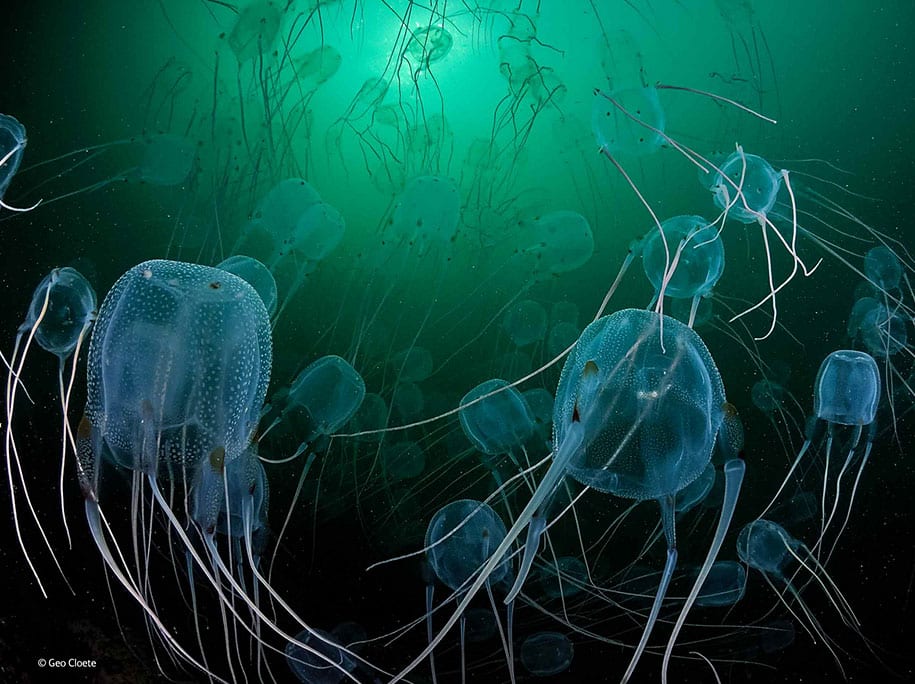
Geo never forgot the vast swarm of box jellyfish he encountered when diving in Hout Bay off Cape Town, South Africa. He had no camera then, but the experience sparked a passion for jellyfish. He fantasised about creating a picture of a huge mass of them, moving ‘like a firework display in slow motion’, their tentacles like star trails. Though Geo occasionally found small groups of box jellyfish around South Africa’s Cape Peninsula, it was seven years before he came across another mass gathering. It was in exactly the same location, in water cloudy with plankton. The 500 or so tightly packed cube-shaped bells would shoot forward when they saw him. Though these small jellyfish have no central nervous system, they have clusters of eyes on the four sides of their bells so, unlike most other jellyfish, they can jet away. ‘Visibility was bad, and so I needed to manoeuvre them so that they were nearer the surface and I could look up at them and outline them against the sunlight,’ Geo says. Swimming into the mass, he braved the stings from their tentacles. With skilful positioning of his strobes to light rather than bleach those in the foreground, he managed to capture the otherworldly image he had in mind. (Photo credits: Geo Cloete, South Africa)
“Feral Spirits,†Finalist In Birds Category
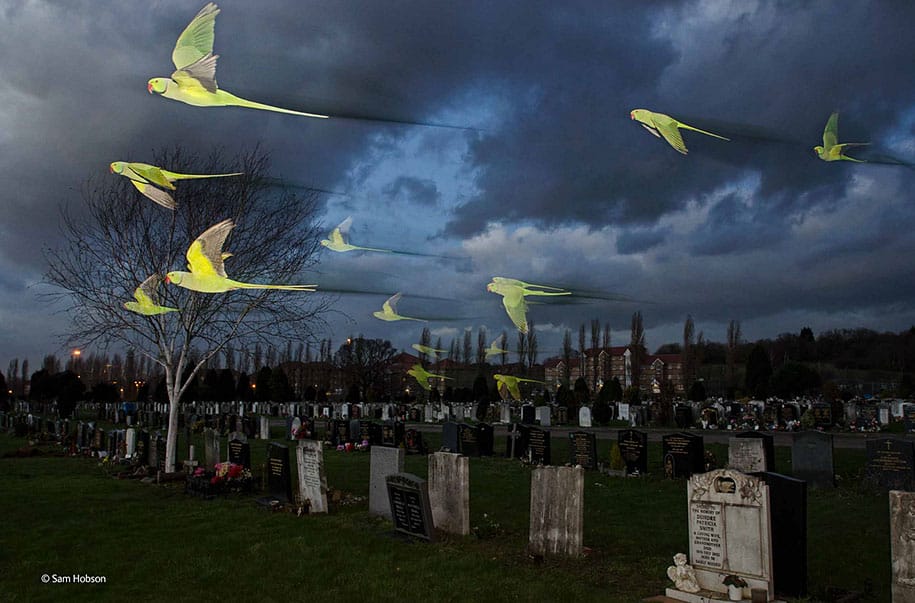
Just before dusk fell over London, the birds would start to appear. Sam says there were ‘swarms of them coming in low across the cemetery, heading for their roost in the trees just behind me. I’d keep having to duck.’ Ring-necked parakeets, an Afro-Asian species, are now well established in the wild in Britain – the result of escapes and deliberate releases from captivity – and they are thriving in London. Their winter roosts can be huge – Sam had checked out several before opting for this one. ‘There were probably 5,000 birds – the noise was amazing,’ he says. With a constant stream of arrivals squawking past in groups of 20 or30, Sam worked out the parakeets’ typical flight paths. He set up his kit, experimented with various techniques and realised they were coming close enough for him to use a wide-angle lens. With a burst of flash at the end of a long exposure to create their ghostly trails, Sam captured the essence of these eye‑catching aliens in the English urban landscape. By the time it was dark, an hour and a half after the first arrival, the fly‑past of thousands was complete. (Photo credits: Sam Hobson, United Kingdom)
“Little Squid,†Finalist In The Underwater Species Category
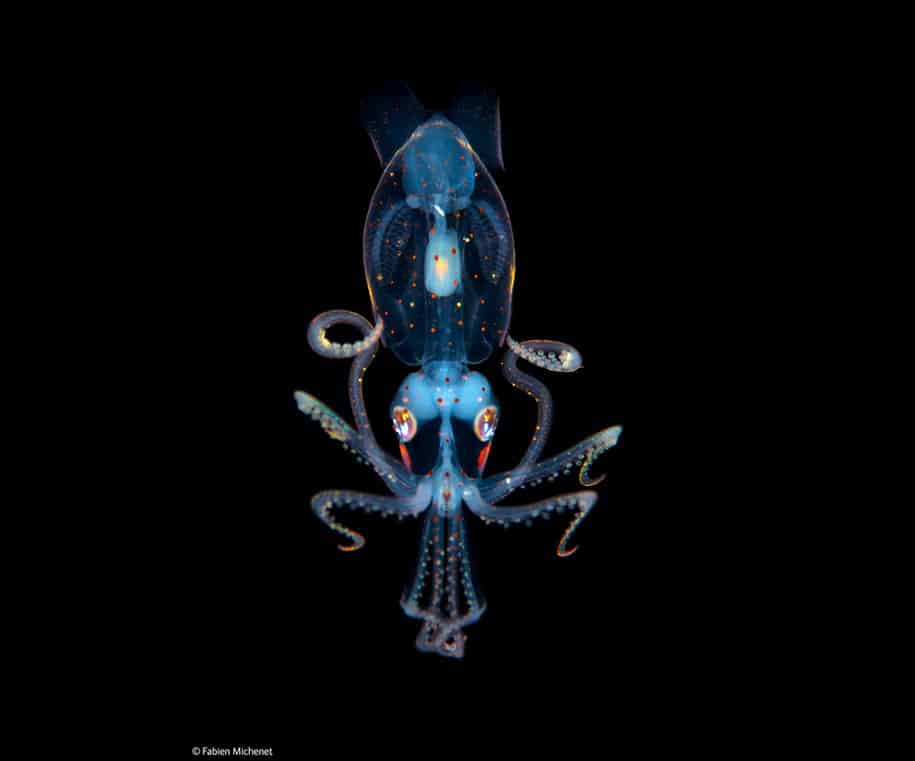
Planktonic animals like this juvenile sharpear enope squid are usually photographed under controlled situations after they’ve been caught. But Fabien is fascinated by the beauty of their living forms and aims to photograph their natural behaviour in the wild. Night diving in deep water off the coast of Tahiti, he was surrounded by a mass of tiny planktonic animals. Apart from the occasional sound of a dolphin, it was silent, and he became fascinated by this tiny squid. Just three centimetres long, it was floating motionless about 20 metres below the surface. It was probably hunting even smaller creatures that had migrated up to feed under cover of darkness. Its transparent body was covered with polka dots of pigment-filled cells, and below its eyes were bioluminescent organs. Knowing it would be sensitive to light and movement, Fabien gradually manoeuvred in front of it, trying to hang as motionless as his subject. Using as little light as possible to get the autofocus working, he finally triggered the strobes and took the squid’s portrait before it disappeared into the deep. (Photo credits: Fabien Michenet, France)
